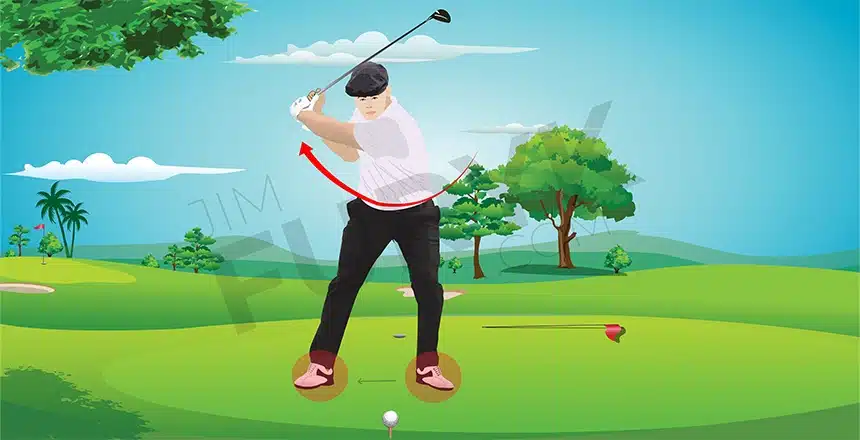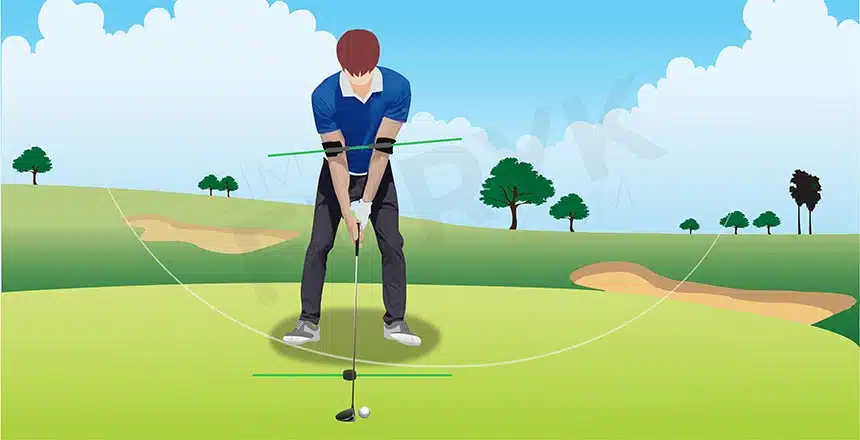A wider swing gives you more space to maximize speed through impact, but that’s not the only way when it comes to understanding how to increase clubhead speed. If you want to hit “explosive” shots, just like a pro, you have to take into account several factors.
Your posture, swing technique, ball speed, flexibility, strength, shaft flex, and how consistently you make sweet-spot contact.
Generating greater clubhead speed is not as simple as increasing your swing speed by using weighted golf clubs during practice sessions. There’s so much more that goes into producing that extra power to make your drives soar HIGH and LONG!
In This Post
- What Is the Average Clubhead Speed In Golf?
- How Do Clubhead Speed and Ball Speed Affect Distance?
- Connection Between Swing Speed, Clubhead Speed, and Distance
- Increasing Clubhead Speed In Golf – Top 5 Proven Methods!
- Increasing Clubhead Speed for Senior Golfers – 4 Most Useful Drills!
- Concluding Thoughts
What Is the Average Clubhead Speed In Golf?
If you look at amateur male golfers, their clubhead speed falls within the range of 80 mph and 90 mph. While PGA Tour players have an average clubhead speed between 110 mph and 115 mph.
As for women, the average is 65-70 mph whereas LPGA pros come in at about 90-100 mph.
You also want to factor in ball speed at this point. Typically, it should be 1.5x faster in comparison to your swing speed. Only then can you maximize clubhead speed potential.
When you find out what your ball speed is, you get to know whether or not you’re squeezing out as much as possible from your golf swing.
How Do Clubhead Speed and Ball Speed Affect Distance?
Did you know that Bryson DeChambeau broke the previously held clubhead speed record? Ryan Brehm’s 128 mph was beaten down by Bryson DeChambeau’s stunning clubhead speed of a little over 132 mph. Although that actually weakens his smash factor and makes him less efficient, here’s why and how (proof that you shouldn’t get too hung up on numbers).
Nonetheless, there’s no refuting the fact that ball speed and clubhead speed (both different variables) matter. The latter involves the speed at which your golf club travels when it hits the ball. The former i.e. ball speed, on the other hand, is the speed at which the golf ball travels right after impact.
In that case, a higher clubhead speed produces a higher ball speed, right? Yes, that is true, BUT the correlation between the two isn’t as simple or exact as that. Let me explain.
Let me present two scenarios:
- More efficient golf swing + lower clubhead speed = faster ball speed
- Less efficient golf swing (meaning not making consistent center-of-the-clubface contact) + higher clubhead speed = slower ball speed
You see how a more efficient, mis-hit-free swing is what matters the most when it comes to boosting ball speed and, ultimately, your distance potential. The difference in ball speed between the two scenarios listed above may be small for Tour-level players, but, more often than not, that gap is way wider in the case of average golfers. And why is that?
An average player is no PGA or LPGA Tour pro, correct? Means if you’re an average golfer, you might be able to generate enough or even a faster clubhead speed. However, it’s most likely that your other swing flaws may get in the way in that they can actually minimize energy transfer to the ball drastically.
At the same time, hooks, slices, or when you tend to hit down on that golf ball or simply just make poor contact, all these errors decrease ball speed, no matter your clubhead speed.
Clubhead speed does indeed help in determining distance, but it’s your ball speed that’s the ultimate pointer when it comes to affecting distance. And ball speed is hugely based on contact, which doesn’t impact clubhead speed at all.
Connection Between Swing Speed, Clubhead Speed, and Distance
So much importance is given to swing speed in golf because almost each and every golfer wishes to hit longer drives and also be able to compress their irons more. With that in place, it’s only logical to assume that clubhead speed plays a major role in achieving both goals.
When the clubhead speed is faster through impact, the golf ball is destined to travel farther. It’s the higher energy transfer from club to ball, that is what causes the latter to move forward – meaning the golf ball comes off the face faster. And the faster this ball comes off, the longer it’s bound to travel.
Hence, increasing clubhead speed will get you to hit the ball farther.
Increasing Clubhead Speed In Golf – Top 5 Proven Methods!

The many ways in which you can increase clubhead speed – both simple and little complicated solutions!
1. Flexibility Training
Honestly, you don’t need “big” muscles to boost your clubhead speed, rather the task at hand demands more flexibility to execute a flawless, consistent golf swing. Thus, flexibility training is a must if you want to become a better golfer. And the best part about flexibility training is that it’s not time-consuming yet is the most efficient.
Here’s how to go about it…
Shoulder Flexibility

Place your left arm across the chest. Then, with the right arm, secure the left one to the body while also gently pushing on the latter to feel a shoulder stretch. And repeat on the other side.
Side Body Flexibility
Stand at a 90-degree angle to a wall. Turn the body to get your abdomen to stretch toward one side. Now grab that wall using your arm, which works as leverage to activate the stretch into those side muscles. Repeat the same on the opposite side.
Both of these flexibility training practices should help in accomplishing the mission of infusing more freedom into your range of motion during the golf swing. And that, in turn, will increase clubhead speed.
T-Spine Rotation and Spider-Man are also two very effective mobility, flexibility, and strength exercises that increase your swing’s range of motion to help you hit longer shots.
2. Strength Training
More specifically, this means weight training makes your muscles stronger, not necessarily bigger. Which muscle groups? Not just your shoulders, chest, and biceps, but also your forearm, hip, and abdominal muscles.
With strength training, you can actually target all the right muscles to develop a more effective golf swing route for increasing clubhead speed and gaining extra yardages.
Although, unfortunately, strength training does require time and effort. Plus, you have to combine it with flexibility training as well, so your muscles are both strong and flexible (because without the latter, strong and/or big muscles won’t make much of an impact).
Here are some exercises you can do for building stronger muscles for golf.
3. Overspeed Training
What is overspeed training? In the game of golf, it means swinging a heavier golf club, so when the added weight (small-sized weighted donuts or weighted golf clubs) is eliminated, you end up swinging faster than your normal speed. And that means an increase in clubhead speed.
Through overspeed training, you can boost your clubhead speed in no time, which is the most amazing thing about it. Just a few golf swings using the weighted club – where you grip the golf club normally and swing it very slowly to build endurance and stability – prior to your shot (or 10 to 15 minutes every day). And, as a result, you end up swinging faster.
However, overspeed training can interfere with your golf swing technique, thus paving the way for bad habits. But you can prevent that by making sure to, once again, perform this drill with slow movements (it also prevents injuries!).
4. Improving Golf Swing Technique
This is kind of an obvious one, right? Because if there are any errors or leaks in your current golf swing approach, then it’s only consequential for your clubhead to get affected unfavorably.
Therefore, this calls for revising or re-setting the complete golf swing sequence, so you’re optimizing the full power and potential of your body. Establish that perfect baseline right away!
Also, improving swing technique could entail hashing out your golf setup basics, golf alignment, and golf grip.
5. Using Swing Align to Increase Swing Speed

Swing Align golf training aid is a very useful tool that ensures proper setup at address. By proper, I mean getting into that perfect square position to your target. This also involves tilting your shoulders the right amount. With Swing Align, you can improve your body position to max out swing speed.
Here’s how to use the Swing Align golf swing training aid the proper way.
Producing a full swing using Swing Align keeps your body and arms well-connected, which compels you to make use of the major muscles for creating and increasing clubhead speed through impact.
Increasing Clubhead Speed for Senior Golfers – 4 Most Useful Drills!
You see senior players hitting the ball straight and long all the time. Now is it because they ALL have a faster swing speed? Nope, that’s not it. Rather it’s because at least most of them are smart enough to choose golf clubs engineered with the most beneficial features, in terms of technology.
For example, the oversized, aerodynamic clubhead shaping of the most forgiving drivers for seniors or the cavity-back, perimeter-weighted design of these top-rated irons for seniors.
Nevertheless, here are some very helpful drills for advancing clubhead speed despite being a senior golfer.
1. The Speed Drill
You can use the attack angle and the loft angle of your golf club to optimize clubhead speed.
- The first step here is to move your hip slightly forward and your spine slightly back, so your chest comes behind the golf ball.
- Angle up your shoulders and, using the trail leg, create support by positioning it at a sharp angle.
- Don’t forget to also straighten the head to keep it higher and upright.
- The next step involves slightly tilting the upper body and picking your golf club, where your hands reach under your chin.
- Your posture at this point is such that there’s a small gap between your thighs and hands.
- Finally, begin to take practice swings while also keeping a check on the speed at which you’re swinging.
2. The Turning-the-Clubhead-Down Drill
Using this particular technique helps to increase your swing speed, so your clubhead speed also receives a boost along the way.
- Grip the driver head in a way that its shaft is placed horizontally before you.
- Now swing the golf club by starting slowly and then gradually elevating the tempo until you’re able to develop consistency in your “swish” motion.
Once your swing becomes faster, the body begins to get involved too, which is just what is needed for dialing up speed.
- Then perform the same drill on the other side of the club. Go for an even louder swish this time (louder swish equals higher speed) by using the lower body to lead your swing and then bringing in the arms.
- It’s time to now take your normal position at address and swing – watch out for that loud swish!
3. The Accuracy Drill
Accurate timing plays a very, very important role as far as improving golf swing tempo is concerned. This way, you can also add more weight i.e. speed into your swing. Just make sure you have a golf towel!
- Tie a knot with the towel and grab both ends to bring the knot to the extreme end.
- Get into your stance and then swoosh that towel back – the knot should come to rest on the trail shoulder. At this point, you ought to be feeling your weight in the lead knee and front foot.
- Now initiate your downswing using a firm, secure grip. Keep in mind that the lower body is leading the arms and hands during the swipe motion.
- Once more, like the previous drill, start slow and gradually build up the tempo.
It’s good to monitor your speed and push to the max. limit of your body and strength.
4. The Sweet Spot Drill
How do you find out if you’re actually hitting the clubface’s sweet spot i.e. center? It’s simple – get a label, like this Jumbo Label Roll, and place it on the clubface during practice sessions.
If you’re using excessive force, you’re definitely going to miss the sweet spot. So to prevent off-center strikes, swing easy by using only 50 percent speed at first and then power through once you hit that sweet spot. Keep practicing of course, after all, Rome wasn’t built in a day!
It’s all about creating the right swing tempo. As you keep practicing, pinpoint both your tempo and swing path to produce a golf swing that hits the sweet spot. Stop worrying about how slow or fast your swing speed is!
Once you begin making sweet-spot contact more consistently, then increase your speed till you can achieve the same results with 100 percent effort/speed.
Can Swing Speed Improve By Using A Weighted Golf Club?
Using a weighted golf club increases the chances of forming bad swing habits. To be more specific, it’s most likely to mess with crucial factors like feel and accuracy – both of which play a major role in your golf swing speed.
Many golfers end up compensating for the lack of extra weight by utilizing different muscles of the body and not just the ones that matter the most.
Does Swing Speed Get Affected by Golf Shaft Flex?
Choosing the right shaft flex based on your swing speed is a must. Generally, a slower swing speed has a slower tempo, which means a more flexible shaft is needed.
Please note that timing also decides a lot in terms of generating a more favorable outcome. Meaning a golf swing that’s well-timed combined with the right shaft flex for you (based on your swing speed) gives you great results.
Concluding Thoughts
There are many ways to boost clubhead speed and, in turn, gain distance. My aim here was to provide you not just with the most effective solutions, but also to explain both the pros and cons of those methods.
If you ask me, working on your flexibility and basic swing technique really helps and gives rise to the most advantageous, long-lasting results. However, you pick what works best for you, so you can start hitting straighter and longer shots the most easily and quickly.


Would be nice to have videos for the speed and turning-the-clubhead-down drills mentioned in this article